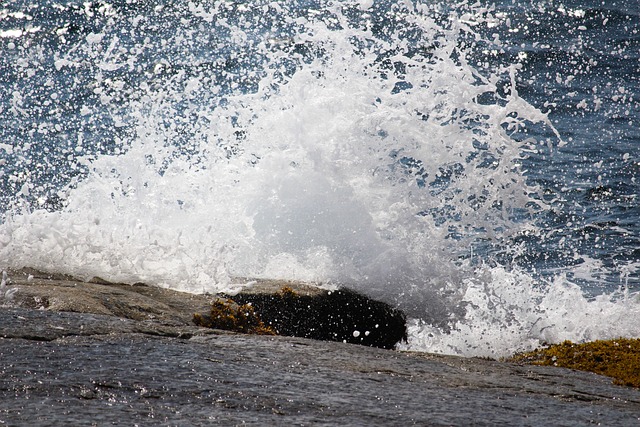Tidal Power: Catching the Waves of Sustainable Energy Innovation

Setting the Stage: The Promise of Tidal Power
Welcome to the fascinating world of tidal power! Imagine harnessing the relentless force of the ocean’s tides to generate clean, renewable energy. As we strive to find sustainable solutions to our energy needs, tidal power emerges as a promising contender. Let’s dive into the depths of this innovative energy source and explore how it can shape our future.
Importance of Sustainable Energy Solutions
In the face of climate change and dwindling fossil fuel reserves, the importance of sustainable energy solutions cannot be overstated. We need reliable and eco-friendly energy sources to power our world without harming our planet. Tidal power, with its predictable and renewable nature, offers a glimmer of hope.
Overview of Tidal Power
Tidal power is a form of hydropower that converts the energy from tides into electricity or other useful forms of power. Unlike solar or wind energy, tidal power is incredibly predictable, as tides are driven by the gravitational pull of the moon and the sun. This makes tidal power a reliable and consistent source of renewable energy.
Understanding Tidal Power
What is Tidal Power?
Tidal power harnesses the kinetic and potential energy of tidal movements to generate electricity. As the tides rise and fall, they create powerful currents that can drive turbines and produce energy. This energy can then be fed into the power grid or used for various applications.
Historical Background of Tidal Energy Use
The concept of using tidal movements to generate power is not new. Ancient civilizations, such as the Romans, used tidal mills to grind grain. However, it wasn’t until the 20th century that technology advanced enough to develop large-scale tidal power plants. The first of these, the La Rance Tidal Power Plant in France, began operation in 1966 and remains one of the largest tidal power stations in the world.
How Tidal Power Works
Tidal power works by capturing the energy from tidal flows. There are two primary methods: tidal stream systems, which use the kinetic energy of moving water, and tidal range systems, which exploit the potential energy from the difference in height (or head) between high and low tides. These systems typically involve turbines, barrages, or lagoons to harness the energy effectively.
Types of Tidal Energy Systems
Tidal Stream Systems
Tidal stream systems utilize underwater turbines placed in tidal currents. As the water flows through the turbines, it causes the blades to spin, generating electricity. These systems are similar to underwater wind turbines and are often placed in areas with strong tidal currents.
Tidal Range Systems
Tidal range systems, also known as tidal barrages, use the difference in water levels between high and low tides to generate power. Barrages are built across estuaries or bays, and turbines are installed within the barrage. As the tide comes in, water is trapped behind the barrage, and when the tide goes out, the stored water is released through the turbines.
Hybrid Tidal Systems
Hybrid tidal systems combine elements of both tidal stream and tidal range technologies. These systems aim to maximize energy capture by utilizing multiple methods of harnessing tidal energy. Hybrid systems can offer increased efficiency and flexibility in various tidal environments.
Technology Behind Tidal Power
Tidal Turbines
Tidal turbines are the heart of tidal stream systems. These turbines are designed to operate underwater and can be either fixed or floating. They capture the kinetic energy of moving water and convert it into electricity through a generator.
Tidal Barrages
Tidal barrages are large structures built across estuaries or bays. They work similarly to dams, trapping water during high tides and releasing it through turbines during low tides. Barrages can generate significant amounts of electricity but also pose challenges related to environmental impact and construction costs.
Dynamic Tidal Power
Dynamic tidal power (DTP) is a relatively new concept that involves constructing long dams perpendicular to the coast. These dams create an artificial head of water that drives turbines. DTP has the potential to generate substantial amounts of energy but requires further research and development.
Tidal Lagoons
Tidal lagoons are artificial structures built along coastlines to capture tidal energy. Unlike barrages, which span entire estuaries, lagoons are self-contained and can be built in various shapes and sizes. They trap water during high tides and release it through turbines during low tides.
Benefits of Tidal Power
Renewable and Predictable
One of the most significant advantages of tidal power is its predictability. Unlike solar and wind energy, which depend on weather conditions, tidal movements are consistent and predictable, driven by the gravitational forces of the moon and the sun. This reliability makes tidal power a valuable addition to the renewable energy mix.
Low Environmental Impact
Tidal power has a relatively low environmental impact compared to other forms of energy generation. It produces no greenhouse gas emissions and has minimal effects on marine ecosystems when carefully managed. Additionally, tidal power plants have a long lifespan, further reducing their environmental footprint.
Long-Term Cost Efficiency
While the initial costs of building tidal power infrastructure can be high, the long-term benefits are significant. Tidal power plants have low operating and maintenance costs, and their longevity ensures a stable and continuous energy supply for decades. Over time, the cost per kilowatt-hour of tidal energy becomes very competitive with other renewable sources.
Challenges and Limitations
High Initial Costs
The construction of tidal power plants requires substantial investment. Building barrages, lagoons, and installing turbines involve significant capital expenditure. However, these costs can be offset by the long-term benefits and the decreasing costs of renewable energy technologies.
Environmental and Ecological Impacts
Although tidal power has a low overall environmental impact, it is not without challenges. The construction of tidal barrages and lagoons can disrupt marine ecosystems, affect sediment transport, and alter tidal flows. Mitigating these impacts requires careful planning and environmental assessments.
Technical and Engineering Challenges
Tidal power projects face various technical and engineering challenges. These include the harsh marine environment, the need for durable materials, and the logistics of constructing large structures in coastal areas. Advances in technology and engineering practices are helping to address these challenges.
Innovations and Technological Advancements
Improved Turbine Designs
Recent advancements in turbine design have increased the efficiency and reliability of tidal power systems. New materials, optimized blade shapes, and advanced control systems are enhancing turbine performance and reducing maintenance requirements.
Advanced Materials and Construction Techniques
The development of advanced materials, such as corrosion-resistant alloys and composites, is improving the durability and lifespan of tidal power infrastructure. Innovative construction techniques, including modular and prefabricated components, are also reducing costs and construction times.
Integration with Smart Grids
Integrating tidal power with smart grids and energy storage systems can enhance grid stability and optimize energy distribution. Smart grids can manage the variable output of tidal power plants, ensuring a reliable and balanced energy supply.
Tidal Power and Climate Change
Reducing Carbon Footprint
Tidal power is a clean and renewable energy source that produces no greenhouse gas emissions. By replacing fossil fuels with tidal energy, we can significantly reduce our carbon footprint and mitigate the impacts of climate change.
Complementing Other Renewable Sources
Tidal power can complement other renewable energy sources, such as wind and solar, to create a more resilient and balanced energy system. The predictability of tidal energy makes it an ideal partner for variable sources, ensuring a stable energy supply.
Long-Term Sustainability
Investing in tidal power contributes to long-term sustainability by providing a reliable and renewable energy source. As technology continues to advance, tidal power can play a crucial role in achieving global climate goals and transitioning to a low-carbon economy.
Global Leaders in Tidal Power
The United Kingdom
The UK is a global leader in tidal power, with numerous projects and research initiatives underway. The country’s extensive coastline and strong tidal currents make it an ideal location for tidal energy development.
France
France has a long history of tidal power, dating back to the La Rance Tidal Power Plant, which remains one of the largest and most successful tidal power projects in the world. France continues to invest in tidal energy research and development.
Canada
Canada’s vast coastline and powerful tidal currents provide significant potential for tidal energy. The country is home to several pilot projects and research initiatives aimed at harnessing tidal power.
South Korea
South Korea has made significant investments in tidal power, with projects such as the Sihwa Lake Tidal Power Station, one of the largest tidal power plants globally. The country continues to explore new opportunities for tidal energy development.
Case Studies of Successful Tidal Projects
The La Rance Tidal Power Plant (France)
The La Rance Tidal Power Plant, located in Brittany, France, is one of the oldest and most successful tidal power projects in the world. It has been generating electricity since 1966 and serves as a model for future tidal energy developments.
The MeyGen Project (Scotland)
The MeyGen project in Scotland is one of the largest tidal stream projects globally. Located in the Pentland Firth, it aims to harness the strong tidal currents to generate clean, renewable energy. The project has successfully completed multiple phases and continues to expand.
The Sihwa Lake Tidal Power Station (South Korea)
The Sihwa Lake Tidal Power Station in South Korea is the largest tidal power plant in the world. It has been operational since 2011 and plays a crucial role in the country’s renewable energy strategy. The plant demonstrates the potential of tidal power on a large scale.
Economic Impact of Tidal Power
Job Creation and Economic Opportunities
The development and operation of tidal power projects create numerous jobs, from construction and engineering to maintenance and research. These projects can stimulate local economies and provide long-term employment opportunities.
Investment and Funding in Tidal Projects
Investment in tidal power is growing, with both public and private sectors recognizing its potential. Government incentives, grants, and partnerships with private companies are driving the development of new tidal energy projects.
Long-Term Financial Benefits
Despite the high initial costs, tidal power offers long-term financial benefits. The low operating and maintenance costs, combined with the predictability and reliability of tidal energy, make it a financially viable option in the long run.
Environmental and Social Considerations
Marine Ecosystem Protection
Protecting marine ecosystems is crucial for the sustainable development of tidal power. Environmental impact assessments and careful site selection can help minimize the effects on marine life and habitats.
Community Engagement and Support
Engaging with local communities and addressing their concerns is vital for the success of tidal power projects. Transparent communication, fair compensation, and community involvement can foster support and cooperation.
Sustainable Development Goals
Tidal power aligns with the United Nations Sustainable Development Goals (SDGs), particularly those related to affordable and clean energy, climate action, and sustainable cities and communities. By investing in tidal energy, we can contribute to global sustainability efforts.
Future Prospects of Tidal Power
Emerging Trends in Tidal Energy
Emerging trends in tidal energy include the development of floating turbines, improved energy storage solutions, and the integration of artificial intelligence for optimized operation and maintenance. These innovations are driving the future of tidal power.
Potential for Expansion
The potential for tidal power expansion is significant, with many untapped locations around the world. Advancements in technology and engineering are opening new possibilities for tidal energy development.
Vision for a Tidal-Powered Future
The vision for a tidal-powered future involves a world where clean, renewable energy from tidal movements powers our homes, businesses, and industries. By continuing to innovate and invest in tidal power, we can move closer to this vision.
Integration with Other Renewable Sources
Combining Tidal with Wind and Solar
Combining tidal power with wind and solar energy can create a more resilient and balanced energy system. Hybrid projects that utilize multiple renewable sources can optimize energy production and enhance grid stability.
Creating a Balanced Energy Mix
A balanced energy mix that includes tidal, wind, solar, and other renewable sources is essential for achieving energy security and sustainability. Tidal power’s predictability complements the variability of other renewables, ensuring a stable energy supply.
Enhancing Grid Stability
Integrating tidal power with smart grids and energy storage systems can enhance grid stability and reliability. Smart grids can manage the variable output of tidal energy, ensuring a consistent and balanced energy supply.
Public Perception and Education
Raising Awareness about Tidal Power
Raising public awareness about the benefits and potential of tidal power is crucial for gaining support and investment. Educational campaigns, community events, and media coverage can help inform and engage the public.
Addressing Public Concerns
Addressing public concerns about tidal power, such as environmental impacts and costs, is essential for building trust and support. Transparent communication and evidence-based information can help alleviate these concerns.
Promoting Community Involvement
Promoting community involvement in tidal power projects can enhance their success. Involving local communities in the planning and development process can lead to better decision-making and increased support for the projects.
Conclusion
Recap of Tidal Power Benefits
Tidal power offers numerous benefits, including renewable and predictable energy production, low environmental impact, and long-term cost efficiency. It is a reliable and sustainable solution to our energy needs.
The Path Forward for Tidal Energy
The path forward for tidal energy involves embracing new technologies, integrating with other renewable sources, and prioritizing environmental and social considerations. By doing so, we can unleash the full potential of tidal power.
Final Thoughts
As we look to the future, it’s clear that tidal power will play a crucial role in our global energy landscape. By balancing innovation with sustainability, we can create a cleaner, greener, and more resilient energy system for generations to come.




